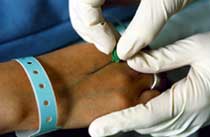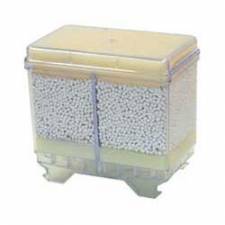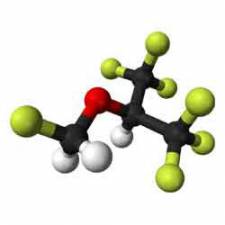 Total intravenous anaesthesia (TIVA) can be defined as a technique of general anaesthesia using a combination of agents given solely by the intravenous route and in the absence of all inhalational agents including nitrous oxide. The intravenous route has been used to administer drugs for hundreds of years and the provision of anaesthesia solely by the intravenous route using chloral hydrate was documented as early as the 1870's. Thiopentone was introduced into clinical practice in 1934 and made intravenous induction of anaesthesia popular. Propofol was introduced into clinical practice in 1986 and now seems to be taking over that role. It has also become widely used as a component of TIVA.
Total intravenous anaesthesia (TIVA) can be defined as a technique of general anaesthesia using a combination of agents given solely by the intravenous route and in the absence of all inhalational agents including nitrous oxide. The intravenous route has been used to administer drugs for hundreds of years and the provision of anaesthesia solely by the intravenous route using chloral hydrate was documented as early as the 1870's. Thiopentone was introduced into clinical practice in 1934 and made intravenous induction of anaesthesia popular. Propofol was introduced into clinical practice in 1986 and now seems to be taking over that role. It has also become widely used as a component of TIVA.
TIVA has become popular, practical and possible only in relatively recent times. There are two main reasons for this. Firstly, unlike other popular intravenous agents of the past, the pharmacokinetic and pharmacodynamic properties of modern drugs like propofol and the newer synthetic, short acting opioids make them very suitable for administration by continuous infusion. Secondly, new concepts in pharmacokinetic modelling and advances in computer technology have allowed the development of sophisticated delivery systems which make control of anaesthesia given by the intravenous route as straightforward and user friendly as conventional inhalational techniques.
Intravenous drug administration to provide anaesthesia has evolved to become a popular alternative to inhalational anaesthesia. This evolutionary process is a result of improved understanding of pharmacokinetics, pharmacodynamics and the interactions which take place during continuous drug administration. Understanding these processes has facilitated the development of computerised syringe drivers that allow optimal drug selection and combinations. New intravenous drug delivery systems allow anaesthetists to vary anaesthetic depth in response to clinical signs in a manner intuitively similar to conventional volatile systems; thus simplifying the administration of intravenous anaesthesia. The result is an easy to use modern system of providing anaesthesia, which allows rapid, precise and independent control of amnesia, hypnosis and analgesia.
Pharmacokinetics and TIVA
Pharmacokinetics is a potentially complex subject but an understanding of the basic concepts in relation to anaesthetic drugs can help to clarify the clinical implications of using a particular drug for TIVA and so assist optimal drug selection and combination.
 The science of pharmacokinetics is simply the use of mathematics to describe how the body 'handles' particular drugs. Data can be gathered by performing plasma assays of specific drugs after administration (by either single dose or infusion) to examine how the plasma concentration changes over time. There is a mathematical relationship between an administered dose of a drug and the resulting observed changes in plasma concentration. This relationship allows mathematical pharmacokinetic models to be constructed that may then be used to facilitate the calculation of dosing regimens and to guide pharmacotherapeutic management.
The science of pharmacokinetics is simply the use of mathematics to describe how the body 'handles' particular drugs. Data can be gathered by performing plasma assays of specific drugs after administration (by either single dose or infusion) to examine how the plasma concentration changes over time. There is a mathematical relationship between an administered dose of a drug and the resulting observed changes in plasma concentration. This relationship allows mathematical pharmacokinetic models to be constructed that may then be used to facilitate the calculation of dosing regimens and to guide pharmacotherapeutic management.
The system of intravenous drug delivery used during TIVA must help to achieve the following goals: smooth induction, reliable and titratable maintenance and rapid emergence. In addition, a system that uses the skills the anaesthetist has already learned administering inhalational anaesthetics would seem logical. Target controlled infusion (TCI) devices have been developed to meet these requirements.
Advantages of Target Controlled Infusion (TCI)
A number of infusion device manufacturers have introduced "open" TCI systems for propofol, remifentanil and sufentanil. These new devices are CE marked. If a company believes that their device meets so called "essential requirements" of performance and safety, and if they have an approved quality system in house, they do not need to submit their device for external evaluation by a statutory body. The medical device regulations do not require any collaboration between device and drug manufacturers, and one could argue that this should be required, to ensure that the device contains an appropriate pharmacokinetic model. Since November 2004 in the UK, the only drug that is licensed for administration by TCI is propofol, from Diprifusor TCI systems. Use of "open" TCI systems could be considered as "off label" drug administration, although if drug delivery rates achieved in TCI mode fall within those advocated in existing labelling for (manual) bolus and infusion dosing it could be argued that delivery is in accordance with the prescribing information. Computerised delivery systems
Intravenous maintenance of anaesthesia after induction can be achieved by simple repeated doses. This has the disadvantage of peaks and troughs in drug concentration, which could result on the one hand, in undesirable toxic effects and on the other, in underdosing. The next logical step then is to give the drug by continuous infusion but the disadvantage with that method is the delay to peak effect, which is the equivalent of four or five drug elimination half-lives. If a loading dose is given at the start of a fixed infusion rate, then an initial peak effect is reached more quickly but there is a decrease in concentration at the transition from loading dose to maintenance, due to drug redistribution. This again introduces a risk of underdosing. To avoid this problem, the maintenance regimen must take into account the decline in drug concentration. In the course of a procedure, changes in anaesthetic depth often need to be swift to respond to variations in degree of surgical stimulation. Although changes in a manual infusion rate will cause predictable changes in blood concentration, the delay in reaching the new higher concentration would usually be unacceptable. To increase the blood concentration more quickly a bolus increment followed by a change in infusion rate would have a quicker onset time but the calculations required to select the correct bolus and new infusion rate are fairly complex. They would certainly not be practical for the individual anaesthetist to carry out in the course of an anaesthetic. Reduction in dose has its hazards too; discontinuation of a manual infusion could result in it inadvertently not being switched back on.
 One answer to all these problems is a computer driven infusion device programmed with specific propofol pharmacokinetic parameters and used to achieve a pre-set target plasma concentration of drug. Multiple complex calculations are clearly the domain of the microprocessor, which can make this process of administering anaesthesia by TCI analogous to that of controlling volatile anaesthesia. A target level is selected by the anaesthetist on the infusion device for induction and is subsequently adjusted in response to clinical signs to maintain adequate anaesthetic depth. There is no need for a bolus induction dose as it is included in the machine's calculations when the anaesthetist first sets the initial plasma concentration. Depth of anaesthesia can be changed swiftly in the course of an operation by simply selecting a new target blood concentration, similar conceptually to adjusting a vapouriser during volatile anaesthesia. The microprocessor makes all the relevant calculations of bolus increment or alterations in the infusion rate that are required to achieve, maintain and alter the blood concentration to any target level programmed by the anaesthetist.
One answer to all these problems is a computer driven infusion device programmed with specific propofol pharmacokinetic parameters and used to achieve a pre-set target plasma concentration of drug. Multiple complex calculations are clearly the domain of the microprocessor, which can make this process of administering anaesthesia by TCI analogous to that of controlling volatile anaesthesia. A target level is selected by the anaesthetist on the infusion device for induction and is subsequently adjusted in response to clinical signs to maintain adequate anaesthetic depth. There is no need for a bolus induction dose as it is included in the machine's calculations when the anaesthetist first sets the initial plasma concentration. Depth of anaesthesia can be changed swiftly in the course of an operation by simply selecting a new target blood concentration, similar conceptually to adjusting a vapouriser during volatile anaesthesia. The microprocessor makes all the relevant calculations of bolus increment or alterations in the infusion rate that are required to achieve, maintain and alter the blood concentration to any target level programmed by the anaesthetist.
The development of Target Controlled Infusion devices
The benefits of TCI have been recognised for some time and computer controlled systems were described in the literature in the late 1980's. Lack of commercial availability, however, prevented widespread use of these TCI systems. In the case of propofol, various TCI prototypes had been developed over the years using different pharmacokinetic parameter sets.
The availability of short-acting, potent hypnotic and analgesic drugs and modern TCI systems make the process of administering TIVA now a practical and straightforward alternative to conventional inhalational anaesthesia. At the same time, improved understanding of drug kinetics, dynamics and interactions has facilitated optimal drug selection and method of administration, which can be easily tailored to clinical requirements. Rapid and precise titration of anaesthetic drugs to provide smooth onset and short, predictable drug offset is now feasible. This may be advantageous in the context of a cost conscious health service moving towards ever shorter inpatient stay and more patients treated as day cases.
The increasing popularity of TIVA is testament to its ease of use and perceived benefits and for the modern anaesthetist it represents a new branch of the speciality with major advantages.
Sources:
http://www.sivauk.org/welcome.php
http://www.pubmedcentral.nih.gov/articlerender.fcgi?artid=1390758
http://www.nature.com/npp/journal/v29/n3/full/1300364a.html
http://www.rila.co.uk/issues/full/download/51c2200970f1a38a5988b71b12d9f52f407682.pdf
http://bja.oxfordjournals.org/cgi/reprint/86/4/523.pdf
John Sandham IEng MIET MIHEEM








